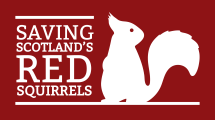…have declined due to their replacement by introduced grey squirrels who outcompete them for food and habitat and spread the deadly squirrelpox virus. Saving Scotland’s Red Squirrels, a partnership project led by the Scottish Wildlife Trust, is working with local communities, landowners, partner organisations and volunteers to protect red squirrels in key priority areas where they are most under threat… […]
Read More…
…times and have since replaced our native red squirrel in many parts of the country. They out-compete reds for food and living space and can also carry squirrelpox, a virus that doesn’t harm them but is fatal to reds. Squirrel sightings, which are collected year-round, help the SSRS project to understand how the distribution of each species is changing over… […]
Read More…
…can make a big difference to our efforts.” Sightings can be reported year-round at scottishsquirrels.org.uk/squirrel-sightings. Saving Scotland’s Red Squirrels is a partnership project led by the Scottish Wildlife Trust and supported by the Scottish Government and The National Lottery Heritage Fund, thanks to National Lottery players, along with other partners. For further information please contact Nicole Still, nstill@scottishwildlifetrust.org.uk, 07423 028689… […]
Read More…
…across the country, reporting an incredible 1549 sightings in just one week. We were particularly keen to see this year’s results due to the impact Covid-19 has had on our annual Spring Survey, which has been cancelled for the past two years. More detailed analysis is ongoing, but the overall distribution of red and grey squirrels across the… […]
Read More…
…single, accidental, introduction event in 1971. Within a few decades, grey squirrels replaced red squirrels throughout Aberdeen city. As their numbers increased they also spread into rural areas along the Dee, beyond Banchory, and the Don, as far as Inverurie, posing a threat to the red squirrels in wider Aberdeenshire and to nearby populations in Moray and the Highlands. SSRS… […]
Read More…
…a variety of talks, workshops and networking opportunities, as well as virtual exhibitions from some of our volunteers and partner organisations. Event access Click ‘reset password’ to set a password for the first time. You must have already registered for the event for this link to work Download programme Trapping and tech workshop Sign up for optional workshop (limited capacity)… […]
Read More…
…outbreak, Saving Scotland’s Red Squirrels will advise on the best means of action for the area, often this entails disinfecting feeders, taking them down and refraining from supplementary feeding for the duration of the outbreak. There is no evidence that squirrelpox can cause any harm to humans, however sensible precautions should be undertaken when approaching any dead or sick wild… […]
Read More…
…a year in Great Britain. Costs are incurred by the agriculture, forestry and horticulture sectors, but also by many other sectors including transport, construction, aquaculture, recreation and utilities. Some invasive species threaten our health or enjoyment of our environment. Rats, house mice and cockroaches are all invasive non-native species that can be serious house pests, and giant hogweed contains a… […]
Read More…
